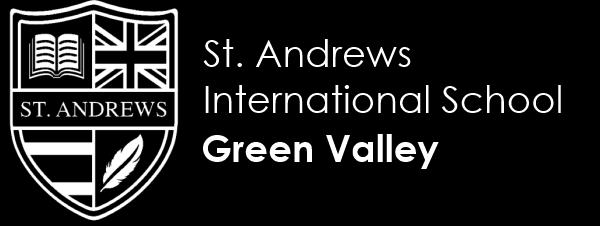




( ) & ( )
My name is Bill Minty and I'm the Head of the EAL and LEAP programs here at St Andrews, Green Valley. I'm from Sydney, Australia, and I've been living and teaching in Thailand for many years in such places as Nakhon Sawan, Surin, Bangkok, and Khao Yai. My family and I love living here in beautiful Rayong.
At St Andrews we aim to cater to your child's individual English language needs in a caring, inclusive and supportive environment. With a combination of in-class support and personalised small group tuition, we strive to ensure your child can access the mainstream curriculum with confidence and success.
Our EAL and LEAP teachers plan collaboratively with the classroom and subject teachers in order to best meet the needs of our EAL and LEAP students. We pride ourselves on providing an environment in which each and every student feels comfortable taking risks, is challenged to produce their best work and hopefully has fun learning English, too!
A major objective is to develop our students' speaking and listening skills and to build confidence in their overall abilities which can then be applied in mainstream classrooms. We also have a major focus on reading skills in order to build students' reading fluency, comprehension,word-recognition skills and vocabulary. We also feel that developing our students’ understanding and usage of basic punctuation and grammar is of utmost importance, especially in order to improve their academic writing.
Please feel free to contact me via email or come and see me in person when you would like to discuss your child's progress and development.

EAL stands for English as an Additional Language and our program at St Andrews, Green Valley, provides intensive English tuition to enable non-native English speakers to build their English skills in order to access the mainstream curriculum.
At St. Andrews, it is the aim that students who have English as an Additional Language will:
• Use English confidently and competently.
• Use English as a means of learning across the curriculum.
• Build on knowledge that they already have of other languages and cultures.
These aims will be achieved by ensuring the EAL students access the curriculum by:
• Providing a welcoming ethos around the school and in classrooms.
• Providing appropriate cultural resources where possible.
• Ensuring that tasks are well supported by concrete and visual materials, especially for pupils in the earlier stages of English acquisition.
• Differentiation in daily planning.
• Staff being knowledgeable about the needs of EAL students.
• Teachers working collaboratively to meet the individual needs of students.
At St Andrews International School we provide support for students at Beginner, Intermediate and Advanced EAL levels. We offer EAL support for students in Years 1-4:
St Andrews International School does not provide EAL provision for students in Early Years as it is expected that the language levels and levels of differentiation expected within Early Years classes will not differ too greatly from the needs of new EAL students.
In June of each year, the Head of EAL meets with Reception teachers to discuss who may need additional language support when entering Year 1. Placement is based on how well students can cope in mainstream classes. Teachers indicate whether the student is expected to be a beginner, intermediate or advanced EAL learner at the start of the new academic year.
The EAL coordinator then sends a letter home to parents of the students identified that explains that their child will receive a free trial for half a term, to further assess and support their language needs in their transition to Year 1. Should a student need to continue in EAL into the second half of the term, parents will be sent an invoice for the second half of term only.
When new students enter the school from Years 1-4, they are initially assessed by the school Special Educational Needs Coordinator and a decision is made as to whether the student will require Beginner, Intermediate or Advanced level EAL support. This level is then given to the Head of EAL who passes on information to the EAL teacher for that year group. During the first 3 weeks of each term, and within 3 weeks of a new arrival, EAL students are assessed by their EAL teachers against the year group benchmarks for reading, writing, speaking, listening and usage (grammar). A decision is then made by the EAL teacher, in collaboration with the class teacher, as to the correct level of support required by students and gives this information to the Head of EAL by week 3 of each new term. This information is then sent to the office for invoicing purposes.
Class and subject teachers may notice students who are struggling with English in their lessons and refer them to the EAL department for assessment. Class subject teachers may use the following criteria for identifying students:
• Language acquisition progress below expected norm
• Unusually slow work rate compared with peers
• Limited response to teacher or peer intervention
• Specific weakness in English language development e.g. poor verbal comprehension, limited vocabulary and use of expression
• Poor listening and attention skills
• Specific weakness in English literacy skills, e.g. difficulties in reading, comprehension or limited unaided writing skills
• Very low standardised assessments
• Formative assessment records
• Parent(s) expressing concern over pupil’s school progress
Accurate first language assessments are useful to give an indication of a pupil’s general language development. Age-appropriate competence in first language tends to indicate that a pupil has EAL needs rather than Learning Support Major gaps in areas in which the pupil has had opportunities to learn may indicate specific learning difficulties other than those related to language acquisition. If still unsure after testing, the Head of EAL may observe pupils in the classroom or ask the Special Educational Needs Coordinator to carry out separate observations and analysis.
Student is identified as needing EAL support by Reception teachers in June and a provisional level is given.
Students are identified as needing E.A.L. on entry to St Andrews School and are allocated a provisional level by SENCO. Parents are informed by office on acceptance. Office forwards acceptance letter to Head of EAL who Students attend EAL in Y1 for free half term trial. If students are not deemed as needing EAL, they may be exited by week 3. The names of remaining students are finalised and proficiency level s are given to Head of EAL by week 3.
Student is tested and observed by relevant EAL teacher and a final decision as to their proficiency level is made by week 3. This information is then passed to the head of EAL
The list of students who will need to remain in EAL for the remainder of Term One and into Term Two is given to the Head of EAL and parents are contacted.
Student joins relevant EAL classes and continues ongoing observation and assessment. Assessment data is collected each half term and recorded. Data collected centrally by Head of EAL
Students achieve peer appropriate levels and are exited from the EAL programme. Head of EAL contacts parents and informs of graduation from programme.
Student is identified by class/subject teacher as needing further language support.
Class/subject teacher to critically assess methods of teaching and, if then needed, carries out a review of child’s progress across other subjects.
Class/subject teacher to meet with Head of EAL to discuss findings and standardised assessment data. Head of EAL to inform parents and arrange (if possible) a first language assessment. If data suggest EAL needs, the Head of EAL will advise parents. If it is considered a SEN issue rather than EAL, data will be passed on to SENCO for further testing/ analysis.
Children with English as an Additional Language needs are taught in mainstream literacy/ English classes whenever possible and supported through a variety of means. These are known as push-in or in-class support classes. When EAL teachers are available for in-class support, they work in collaboration with the class teacher to support identified children.
EAL learners may also be withdrawn from mainstream lessons by EAL specialists to help secure understanding at an appropriate level to the individual child. These are known as pull-out classes. In primary school, this support typically takes place during literacy lesson time. In order to provide adequate EAL support to students, the intention is to have a maximum of 6-8 EAL students per pull-out class.
The aim is to provide the students on the EAL register the following minimum weekly allocation of additional support from the EAL department:
The EAL fees are a separate payment, not to be confused with termly school fees. The parents of new students entering the program and those who are continuing to receive support in a new term will be informed by letter (which will accompany the invoice for the fees).
Reports are completed before the end of each term in December, April and June. In the general primary/secondary reporting package is a separate EAL report that focuses on specific EAL targets.
Parents are given formal opportunities to discuss their child’s progress on two separate occasions throughout the year (Parent / Teacher Conference Days). However, informal discussions pertaining to E.A.L. students’ progress are encouraged by either email or faceto-face meetings.
• To enable EAL students to use English confidently and competently as a means of learning across the curriculum
• To build on knowledge that students already have of other languages and cultures
• To provide appropriate cultural resources where possible
• To ensure that tasks are well-supported by concrete and visual materials, especially for pupils in the earlier stages of English acquisition
• To ensure all staff are knowledgeable about the needs of EAL students.
• To work collaboratively with class/subject teachers to meet the individual needs of students
• To match mainstream objectives to relevant EAL objectives
• To share EAL student learning objectives with mainstream English teachers
• To share EAL strategies with mainstream English and other subject teachers
• To identify and plan for various language learning opportunities within the lesson
• To monitor progress of EAL students and plan lessons and programs of study accordingly
• To design or develop differentiated resources to better enable students’ access to the curriculum and development of EAL in EAL classrooms
• To provide, suggest, modify or design differentiated resources to meet the needs of EAL students in mainstream classes
• To enable students in the EAL program to transfer skills from one subject to another.
Students’ attainment in EAL is assessed through a combination of formative assessment in EAL classes and summative assessment in their mainstream classes. Primary EAL students are regularly assessed every half-term by way of PM and Probe reading tests that gauge their reading levels and reading ages. Students also produce writing samples every halfterm in order to have their writing levels assessed. This information helps inform planning and provides the EAL and classroom teachers with data concerning their students’ progress both individually and in comparison with their non-EAL classmates. Secondary students are, likewise, regularly assessed by way of SATs tests that indicate students’ reading and writing levels.
EAL teachers meet weekly with their EAL students’ classroom teachers to discuss lesson content and to ensure that EAL students can access the curriculum by meeting the same objectives as their non-EAL cohorts. The progress of these students and strategies for improvement are also discussed weekly.
The class teacher and EAL department review their students’ progress collaboratively to decide when the student is ready to function within the mainstream classroom without additional support.
Once it is determined that a student is able to access the curriculum at a level comparable to non-EAL students, then that student is able to exit the EAL program. In secondary, students exit the EAL program if it is generally agreed that the student meets the standards of non-EAL students in the lower sets of mainstream English classes.
LEAP stands for Learning English with Accelerated Progress and our program at St Andrews, Green Valley, provides intensive English tuition to enable non-native English speakers to build their English skills in order to access the mainstream curriculum.
At St. Andrews, it is the aim that students who are supported by LEAP will:
• Learn to use English confidently and competently.
• Use English as a means of learning across the curriculum.
• Build on knowledge that they already have of other languages and cultures.
• Progressively decrease the level of LEAP support they receive and enter appropriate mainstream subject classes.
These aims will be achieved by ensuring the LEAP students:
• Receive personalized support (including homework) that is differentiated to their English language needs.
• Become agents in their own learning progression through a transparent assessment process.
• Learn in a group setting with English as the language of instruction.
• Are integrated into the whole school community through mainstream subject attendance and whole school events (Island Community events, Be Well Day, Activities, etc.).
• Are supported by collaborative communication between the LEAP department and subject teachers.
• Are supported by open communication between the LEAP department and parents.
At St Andrews International School we carry out assessments during the entry procedure and make recommendations on the support your child should receive.
The LEAP programme aims to support students from Years 5 to 9. Students are continually assessed and subject to meetings between subject teachers, the LEAP department and school leadership. Recommendations for progression within the LEAP system are communicated to parents.
Your child will attend LEAP lessons in a separate classroom with students from different age groups. They will study in diverse groupings, with English as the language of instruction, receiving teaching tailored to their needs through ongoing assessment.
Your child will be involved in the transparent assessment process and will be an agent of their own learning; they will know their learning goals and how to make progress.
This will be achieved in small group settings through:
• Developing grammar awareness
• Building vocabulary
• Developing writing strategies
• Developing reading strategies
• Developing listening strategies
• Developing speaking fluency through games and activities
• Attending the library and being guided to choose appropriate reading materials
• Developing the ability to express ideas in English through hands-on activities
• Developing research skills and the ability to find appropriate research content in English
• Accessing personalized Mainstream subject content
The LEAP fees are a separate payment, not to be confused with termly school fees. The parents of new students entering the program and those who are continuing to receive support in a new term will be informed by letter (which will accompany the invoice for LEAP fees).
RAG (Red, Amber, Green) reports are provided to parents every 4 weeks and contain information about your child’s English, academic and social progress. Reports are completed before the end of each term in December, April and June. In the general primary/secondary reporting package is a separate LEAP report that focuses on specific LEAP targets. Parents are given formal opportunities to discuss their child’s progress on two separate occasions throughout the year (Parent / Teacher Conference Days). However, informal discussions pertaining to LEAP students’ progress are encouraged by either email or pre-arranged face-to-face meetings.
Students are continually assessed against the LEAP Progression document which involves assessing your child against the following criteria:
• Ongoing observed Reading, Writing, Listening and Speaking performance in the LEAP classroom
• Ongoing observed Reading, Writing, Listening and Speaking performance in the Mainstream Subject classrooms
• A formal Reading assessment
• A formal Writing assessment
• A formal Listening assessment
• A formal Speaking assessment
For more details on LEAP assessments, please see pages 11 (Primary LEAP) and 12 (Secondary LEAP).
The LEAP department is in constant dialogue with subject teachers and leadership to fulfil the aim to Progressively decrease the level of LEAP support they receive and enter appropriate Mainstream subject classes. Decisions about when to change a students’ LEAP level (and when they can enter more subject classes) are typically taken at the end of each term but are also subject to an ongoing review to ensure the maximum possible personalisation of the programme for each student.
The LEAP programme aims to help your child to Learn to use English confidently and competently so they can succeed in external exams such as the IGCSEs. We also support children to access a range of Entry Level Exams in Science, English and Maths that are designed for English Language Learners.
Decisions about what external exams a student will take will be made on a case-by-case basis and are subject to agreement between the student, teachers, school leadership and
The LEAP Progression document includes 3 Levels and are outlined in more detail on the following pages.
Develop phonic awareness
Build early grammar structures and vocabulary
Strengthen foundation level vocabulary and grammar
Begin to access more mainstream subject content through personalized teaching
Spend the majority of LEAP time working towards personal mainstream subject learning objectives
Exit at 80% Starters Exit at 80% Movers Exit at 80% Flyers
Lilac to Orange B
Flyers
Turquoise A to Gold B White A to Brown B Grey A onwards
Join PE, Music, Art, Maths, DT, Thai Culture, Drama and Forest School
Start joining Science, Computing, Geography and PSHE
Start joining English, History and Languages

